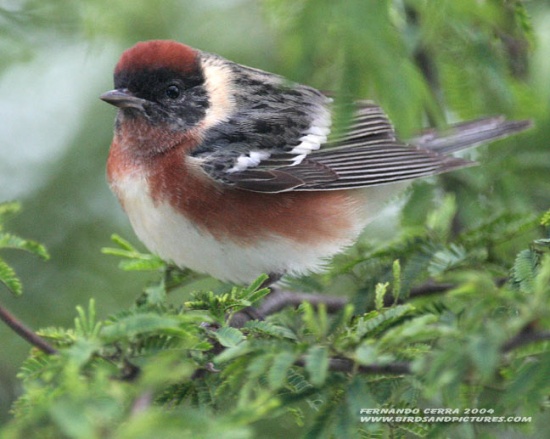- Setophaga castanea
Dendroica castanea
Identification
14 cm (5½ in)
Basic/immature (Sep-Nov): Narrow pale lemon supercilium and brighter narrow eye-crescents; underparts dirty pale buff to pale lemon, often with pinkish-cinnamon wash on flanks.
Alt Male (April-June): Face black with chestnut crown and throat, pale buff sides of neck. Underparts dirty pale buff, chestnut on sides and flanks.
Distribution
Breeds North America from southern [[Northwest Territories east and south to eastern Quebec and western Newfoundland south to northern Minnesota and Michigan, northern New York, northern Vermont and New Hampshire and most of Maine.
Winters Panama to Venezuela. In migration found across the eastern United States. Rare vagrant in the western United States.
Accidental vagrant to Greenland (1 record) and Great Britain (1 record).
Taxonomy

Photo © by Jones Stanley Jones
Canopy Tower, Canal Zone, Soberania National Park, Semaphore Hill, Panamá Province, Panama, February 2018
This is a monotypic species[1].
Formerly placed in genus Dendroica.
Habitat
Coniferous forests in boreal regions.
Behaviour
Diet
The diet includes insects and spiders, supplemented by winter fruit.
Breeding
The nest is placed in a dense spruce tree and the open cup is formed from twigs and bark, held together with spider's web lichen and plant down. It is lined with pine needles, hair and moss etc. The clutch normally consists of 4-7 eggs, which are white or cream with dark spots.
References
- Clements, J. F., T. S. Schulenberg, M. J. Iliff, D. Roberson, T. A. Fredericks, B. L. Sullivan, and C. L. Wood. 2017. The eBird/Clements checklist of birds of the world: v2017, with updates to August 2017. Downloaded from http://www.birds.cornell.edu/clementschecklist/download/
- Avibase
- Allaboutbirds
Recommended Citation
- BirdForum Opus contributors. (2025) Bay-breasted Warbler. In: BirdForum, the forum for wild birds and birding. Retrieved 12 May 2025 from https://www.birdforum.net/opus/Bay-breasted_Warbler
External Links
GSearch checked for 2020 platform.1





